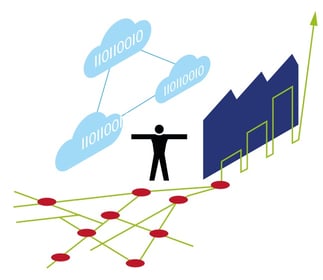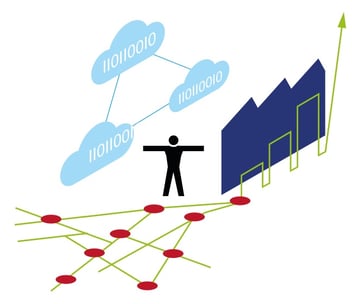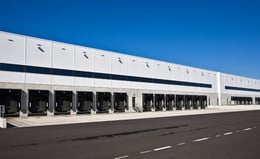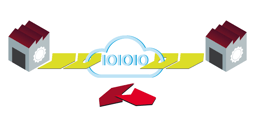Is Your Transport Network a Source of Supply Chain Risk?
Jesse Kelber - February 04, 2020

 Where does risk come from? Is it an external force? Something from within? Or is it what happens when you’re not prepared for an unexpected event? In our experience, it’s the combination of all three of these forces, acting on your weekend plans, your work project, or your supply chain. How do you address these risks? Reactively, by waiting for the disruption to occur and then working feverishly to repair the damage and return everything to normal operation? Or proactively, by defining plans and processes so that when a disruption happens, you and your team can follow the established steps to return to normalcy? Again, we would posit that it’s in finding the right balance between these options, allowing you to proactively plan for any contingency you may have to react to, that you’ll find risk management success.
Where does risk come from? Is it an external force? Something from within? Or is it what happens when you’re not prepared for an unexpected event? In our experience, it’s the combination of all three of these forces, acting on your weekend plans, your work project, or your supply chain. How do you address these risks? Reactively, by waiting for the disruption to occur and then working feverishly to repair the damage and return everything to normal operation? Or proactively, by defining plans and processes so that when a disruption happens, you and your team can follow the established steps to return to normalcy? Again, we would posit that it’s in finding the right balance between these options, allowing you to proactively plan for any contingency you may have to react to, that you’ll find risk management success.
And when it comes to your supply chain, what would you say are the top sources of risk? From our experience again, the list will look something like “weather-related disruptions, erratic fuel prices, political uncertainty, natural disasters, and aging infrastructure.” We’d like you to notice that the one supply chain segment most impacted by the majority of these sources of disruption is your transportation network. Are you ready to mitigate the impact of climate change on your shipping routes? How can your network adapt and pivot to overcome a potential disturbance in the event of a trade dispute? If you don’t have answers to these questions on hand, you might be courting supply chain risks.
Creating a Robust Risk Management Program
In order to react efficiently and effectively when the unexpected happens, supply chain managers need to plan ahead by creating a thorough, comprehensive, and well-documented risk management plan. In order to make sure things can get back up and running as quickly as possible, you need to make every relevant stakeholder in your transport network this plan, trained in how to react to different scenarios, and aware of where the documentation is kept. Every company’s specific needs will vary, of course, but there are a handful of fundamental steps you can take to ensure that your transportation network risk management plan is complete:
- Start by examining existing processes and standards. Where are they fully fleshed out/where could they be better defined?
- Develop support from the highest levels and include every department and partner with a stake in your transportation network.
- Use the most powerful risk analysis tools available, then report results as simply as possible to maintain support from all stakeholders and customers alike.
A strong risk management plan provides other benefits, such as helping convince new clients to come on board. When they see what a solid understanding of potential risk your company has, and then they see your comprehensive management plan, they’ll be that much more likely to sign up knowing their orders are in good hands.
Resilience Is Key
Any risk management solution must be able to suggest, on the fly, things like when to send a shipment out or when to reconfigure a freight route. That means being able to take in data on weather patterns, fuel costs, border situations, and more in real-time. From there, you need to generate multiple possible schedules that take those factors into account. For example, say the data shows a potential ice storm hitting your usual shipping route on Monday, do you send the shipment early so it passes the affected area before the storm hits? Or should you delay shipment so that your trucks pass after the residual ice has a chance to melt? Weighing factors like potential damage to trucks, employees, and goods against the possibility of the shipment being a day late is an area where advanced analytics can be incredibly important to the risk analysis process. These kinds of analytics processes offer a level of resiliency that will allow you to pivot quickly to avoid disruptions before they have a chance to affect your supply chain.
Integrated Systems Can Provide Early Warnings
How much of your transport network is in-house and how much is outsourced to shipping partners and TPLs? Do your systems know everything that their systems know at any given time? What impact would you see if your system received notice from a TPL of a port strike at one of the ports of call you regularly use? If that message got to you in time, you could potentially redirect any shipments heading that way to a backup port and suffer no ill effects. Integrating your SCMS with each downstream logistics partner is the single most impactful thing you can do to mitigate transport network risk. Without this integration, you risk dependent segments of your supply chain not knowing what factors are impacting the segment just up- or down-stream. With it, your in-house solutions can work with those of your partners to analyze the end-to-end supply chain situation and take action to mitigate risk as soon as it’s detected.
Use Industry 4.0 Technology Where Possible
Detection systems can warn of impending weather events, instability in cargo mid-transport, or even upcoming road work delays. Modern supply chain management software solutions often include modules that can analyze for risk and automate the process of developing alternative plans. This degree automation is possible thanks to the AI-powered algorithms and advanced analytics engines that power these solutions. The planning tools built into sophisticated, Industry 4.0-enabled SCM solutions can be used to modify shipping schedules to work around forecasted storms or to redirect trucks to locations with more favorable fuel prices. Eliminating risks proactively in this way will save your time, energy, and budget—not to mention keeping you in good standing with your clients who are receiving their orders right on time.
Some Risk Can’t be Eliminated, so Be Prepared to Mitigate
Climate change tops this list, and that resilience we talked about above is the key to weather the coming storm rather than being swamped by it. Of the disruptions listed in the intro, only a couple frequently give early warnings: weather events and political unrest like strikes or trade disputes. That leaves you to deal with the risks posed by the others (erratic fuel prices, political uncertainty, natural disasters, and aging infrastructure). Are you ready to mitigate the effects of a freak landslide taking out a major shipping route? If you’ve got your systems integrated, are using Industry 4.0 technology in strategic ways to feed the relevant data into your SCMS for risk analysis, and are agile enough to pivot with little notice—you’re more likely to weather the proverbial storm along with the real one.
LATEST POSTS
- Understand Circular Economy in The Manufacturing Industry
- How Can Industry 4.0 IT Integration Be Achieved Smoothly?
- The Significance of Order Sequencing in Discrete Manufacturing
- How to improve your Supply Chain Management: The Power of Control Towers
- Optimizing Human Resource Scheduling in Manufacturing: A Technological Approach



